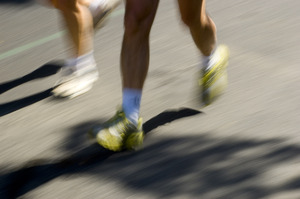Runners or joggers often get hip pain, but could this be from bursitis, as in trochanteric (relating to region)? I consulted with Darrin Bright, MD, who specializes in sports medicine and family medicine, of Max Sports Medicine in Columbus, OH. I’m also a certified personal trainer.
Dr. Bright explains, “Trochanteric bursitis is very common among runners. In order to understand trochanteric bursitis, it is important to have an understanding of what a bursa is. A bursa represents a fluid filled sack that allows structures to glide smoothly over other structures. Bursitis occurs when the bursa becomes inflamed from repetitive movement or excessive pressure.”
Right off the bat, you see how running or jogging can easily be a cause of hip bursitis, what with all of the repetitive movement going on in the hip joint.
Dr. Bright continues, “In this case, the greater trochanteric bursa lies on top of the hip bone, allowing the iliotibial band to glide smoothly over the hip bone. Running results in repetitive movement of the IT band over the bursa, which may result in greater trochanteric bursitis. Similarly, if the IT band is tight it will exert excessive pressure on the bursa, resulting in greater trochanteric bursitis.”
What kind of exercises are therapeutic for bursitis of the hip caused by running? Dr. Bright says, “Physical therapy (PT) is an integral part of the recovering from greater trochanteric bursitis. PT is directed at stretching the iliotibial band as well as strengthening the gluteus medius and other hip external rotators.”
Here are a few exercises for strengthening the gluteus medius and gluteus minimus, which are responsible for external hip rotation (the major “butt muscle,” the gluteus maximus, enables hip extension).
#1. The hip abduction machine at your gym. This isolates the hip rotator muscles.
#2. Get on all fours. Keeping one knee on the floor, lift the other leg (think of how a male dog lifts one leg to relieve itself) so that the inner thigh is parallel with floor, but lower leg bent so that there is a 90 degree angle at the knee. Thighs are perpendicular to each other. Then lower. Do repetitions this way. You should feel the outside of your hip and upper thigh working. This exercise will fatigue the hip rotators quickly. Switch sides.
#3. Inline skating, especially up hills, will target the hip rotators. (If this aggravates hip bursitis pain, then don’t do it.)
#4. Stand with feet shoulder width apart. Lift one leg into a high-march position, but don’t extend lower leg. Now rotate upper leg to the side so that the knee is to your side, maintaining the high-march position, then return to starting high-march position. Repeat for reps, keeping knee high. This will tire you quickly if you’re not used to doing isolation work for hip rotators. Switch legs.
If someone has hip trochanteric bursitis, how long should they avoid running? Dr. Bright explains,“Recommendations regarding running with greater trochanteric bursitis will vary depending on the degree of injury. I usually recommend using pain as your guide. If the pain is affecting your gait or you are limping, then you should not run. Otherwise if you aren’t limping try some easy running and see how it goes. Avoid hills and up-tempo or faster running. Icing after activity and again at bedtime can help with the inflammation in the bursa.”




